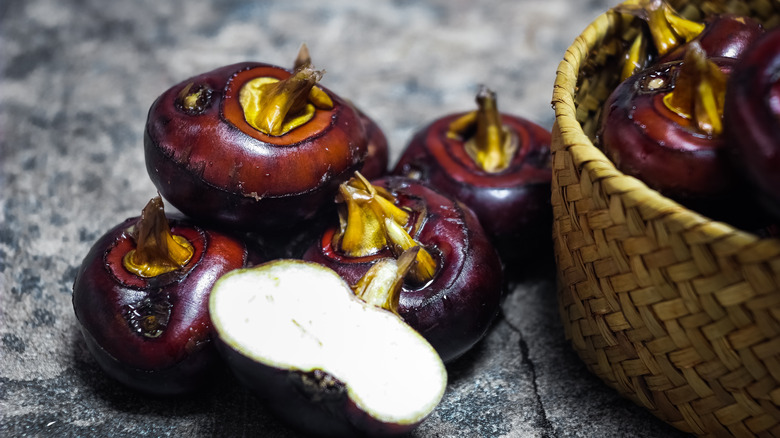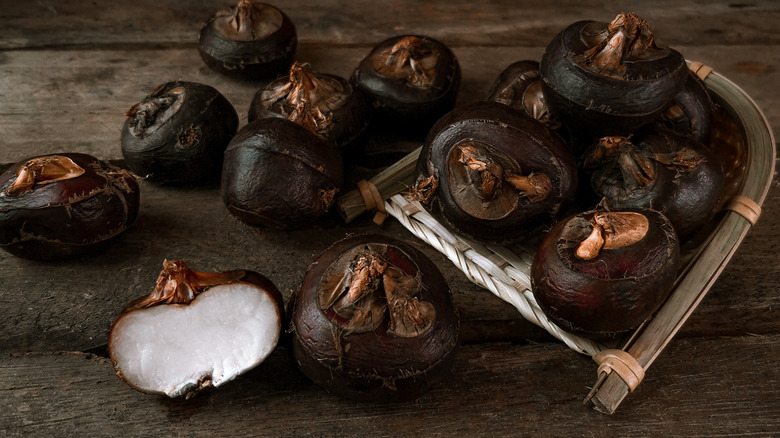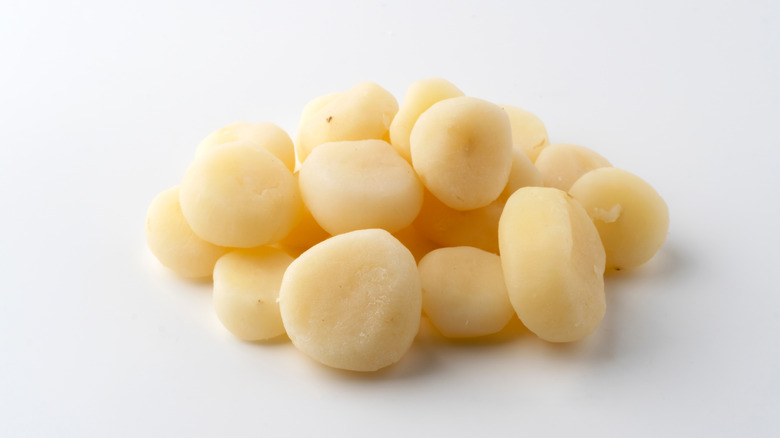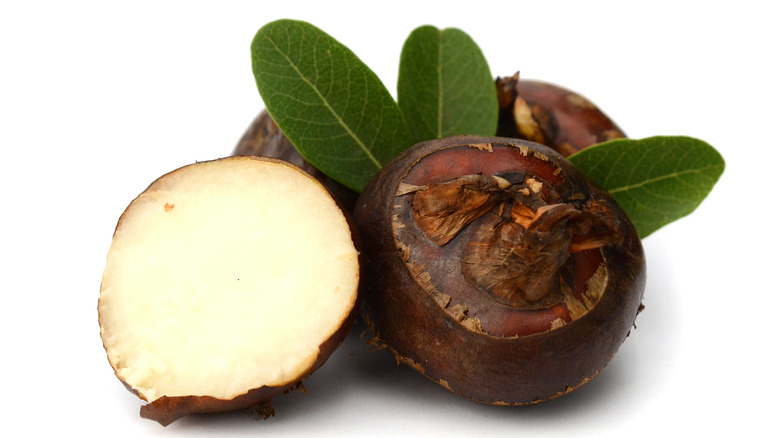What Are Water Chestnuts And What Do They Taste Like?
In a 1992 article from the Chicago Tribune, a reader asks, "what are water chestnuts? I know they're the little things that come in a can, but other than that, I'm not sure where they come from or what other foods they are related to."
It's safe to say that not much has changed in the perception of water chestnuts since that question was asked a few decades ago. A mainstay in Chinese cuisine, water chestnuts add a trademark, slightly brittle crunch to a slew of classic dishes such as moo goo gai pan. While many people are only familiar with the sliced and canned variety, fresh or whole water chestnuts are delicious and an amazing inclusion in almost any recipe. No matter which variation you have on hand, incorporating water chestnuts into your home cooking will diversify your cooking repertoire, boast numerous health benefits, and allow you to embrace an oft-discarded ingredient that can add such wonderful texture and flavor to a dish.
Where do water chestnuts grow?
It's important to note that their name is a misnomer: water chestnuts (eleocharis dulcis) are not any kind of nut whatsoever. The common appearance of water chestnuts — slightly porous, lily-white, flat disks — is in sharp contrast with its actual natural aesthetic: a knobby, dark, and root-like aquatic tuber. (To be fair, it slightly resembles a large nut — hence the name.) The Spruce Eats notes that they are native to Southeast Asia and semitropical climates such as Florida. They grow underwater. Chefs and food writers Fuchsia Dunlop and Eileen Yin-Fei Lo both agree that the vast difference between fresh and canned can have a massive impact on the quality of a dish (via Serious Eats).
Water chestnuts grow at the "water's edge" and in grassy areas along the water, according to Serious Eats. The endearingly misshapen, nut-like product is firm when ripe, and its unappealing appearance belies its pale, sweet flesh.
What do water chestnuts taste like?
Water chestnuts are known for their distinctive, crisp bite that helps to add texture and variety to the dishes in which they're commonly found. Primarily used in Chinese dishes such as stir-fries, water chestnuts are also delicious in any food that could benefit from their light, vegetal flavor and considerable crunch.
In regards to the flavor, canned water chestnuts are incredibly mild; adding more to a dish texturally than do they do flavor-wise. Serious Eats notes that fresh water chestnuts, on the other hand, are "sweet and nutty and tart all at once, like a cross between a coconut and an apple, with the texture of an Asian pear." If you're lucky enough to find fresh water chestnuts, you'll need to peel the skin, remove the root ends, and rinse prior to cooking — but trust us, the extra effort is worth it.
Are water chestnuts healthy?
Canned water chestnuts can be purchased nearly everywhere, while fresh are available at Asian markets. Canned are usually sold whole or sliced. In addition to stir-fries, wontons, dumplings, and meatballs, another popular recipe over the years has been bacon-wrapped water chestnuts. They are also sometimes eaten raw. In addition, they're also delicious when incorporated in dips, various sauces, and salads. They're also great in lettuce wraps and offer an appealing bite that is totally vegan and dairy-free. Perfect Keto suggests they aren't particularly keto-friendly — low-calorie, but "packed with carbs." Paleo Safe, however, declares them "allowed" on the paleolithic diet.
Water chestnuts are packed with potassium, and are also high in fiber and vitamin B6. Livestrong also notes that they are very low-calorie; have almost no cholesterol, sodium, or fat; and are an excellent source of antioxidants, while Healthline states that they can be helpful in lowering blood pressure, reduce risk of heart disease, promote weight loss, and help to prevent cancer.
Hopefully, water chestnuts will be further appreciated for their unique taste and texture instead of merely being relegated to the background of various dishes.



